Behaviour in Scottish schools: research report 2023
This report is the fifth (2023) wave of the Behaviour in Scottish Schools Research, first undertaken in 2006.
Chapter 9 – Approaches used in schools
Summary of findings
Across the survey and qualitative research, there was evidence of a culture shift towards a focus on relationships, restorative practice and Nurture approaches and away from punitive approaches. Nurturing approaches, the promotion of positive behaviour through whole-school ethos and values, and restorative approaches were commonly used across primaries and secondaries to both encourage positive relationships and behaviour and manage serious and low level disruption.
School staff interviewed as part of the qualitative research highlighted the positive impact of particular programmes and broader approaches, particularly in terms of the adoption of whole-school values, and emotional programmes in primary schools. Staff also described changes which had been made to the physical environment and the structure of the school day to promote positive behaviour and relationships (e.g., the use of sensory rooms, break out areas, alternative learning zones, Nurture bases, a tailored curriculum etc). These adaptations were viewed as particularly important for those pupils with mental health issues, or those who were anxious about returning to school after COVID-19.
However, the extent to which positive approaches had been embedded across schools participating in the qualitative research varied, with some teachers and support staff remaining sceptical as to the effectiveness of positive approaches. Staff noted the challenges associated with Nurture and restorative approaches in terms of the time and resources needed to implement these successfully. In the survey, staff reported spending longer on behaviour-related issues and tasks than in 2016.
The survey found the frequency of use of punitive approaches such as detention, punishment exercises and exclusions have decreased since 2016. Overall, the majority of school staff surveyed at both primary and secondary level were positive about their school’s ethos and culture. However, perceptions were much lower in secondary schools and ratings of school ethos and culture have declined in all staff groups since 2016.
When asked to rate how their school promotes policies on positive relationships and behaviour, most (72%) of both primary school teachers and support staff rated their school as good or very good. Again, perceptions were lower in secondary schools, with 46% of teachers and 51% of support staff rating this as good or very good and ratings have decreased since 2016 (from 52% among teachers and 57% among support staff).
Teachers’ confidence in their ability to ‘promote positive behaviour’ and ‘respond to indiscipline’ in the classroom, both in primary and secondary schools remains high[85], although confidence in their ability to ‘respond to indiscipline’ has decreased since 2016.
Staff described improvements to the way that behaviour is described and understood, particularly the understanding of the impact of trauma and neurodiversity on pupil behaviour and the use of trauma-informed language and approaches. The qualitative research found that there is still progress required in terms of how relationships and behaviour, and the approaches used to promote and manage these, are communicated to, and understood by, teachers and support staff. Primary and secondary school staff interviewed at all levels criticised the perceived lack of consequences in current positive approaches to relationships and behaviour and called for this to be addressed in the future. School staff highlighted a perceived mismatch between the positive approaches espoused at both a national and LA level and the realities of dealing with violent and aggressive incidents in schools and highlighted the need for greater consistency in approaches to behaviour, both among teachers and schools. In addition, staff expressed concern at the perceived lack of alternative options and resources for pupils for whom mainstream education may not be appropriate.
Introduction
This chapter explores the range of approaches[86] schools use to encourage positive relationships and behaviour and to respond to disruptive behaviour, how these have changed over time and the perceptions of staff on how these approaches work in practice. Next, the ways in which policies on promoting positive behaviour are development and communicated and which members of the school community are most frequently involved in actively developing behaviour and relationship strategies are addressed. Perceptions of the overall ethos of the school are also explored. Finally, this chapter considers the effectiveness of these approaches and the changes staff would like to see at a national and local level to assist them with relationships and behaviour.
Approaches used in schools
The survey asked headteachers and teachers to indicate how often, if at all, each of 32 different approaches were used in their school. The answer options were: ‘frequently’, ‘sometimes’, ‘rarely’, and ‘never’.
Approaches used in primary schools
Primary headteachers and primary teachers both report that the most frequently used approaches in their schools are promotion of positive behaviour through whole-school ethos and values (100% of headteachers and 98% of teachers said this approach was used ‘frequently’ or ‘sometimes’ in their schools); sharing appropriate strategies and approaches within school/staff (99% headteachers, 95% teachers); Nurture approaches (96% headteachers, 96% teachers); curriculum programmes in social and emotional skills and wellbeing (98% headteachers, 94% teachers); and restorative approaches (97% headteachers, 95% teachers). Table 9.1 shows the 10 most commonly reported approaches used in primary schools.
There are several differences in the reported level of use of approaches between primary headteachers and primary teachers. Teachers are more likely than headteachers to report home-school link officers/work with families being used ‘frequently’ or ‘sometimes’ in their school (69% teachers, 57% headteachers) and pupil/behaviour support base in school/campus (44% teachers, 30% headteachers) being used in their schools. Headteachers are more likely than teachers to report targeted small group work, such as anger management, (82% headteachers, 72% teachers) and time with a key adult (e.g. a counsellor) (80% headteachers, 66% teachers) being used frequently in their schools.
Of the 32 approaches used in primary schools, only circle time is used in different proportions in P1-3 and P4-7 (87% of P1-3 teachers and 79% of P4-7 teachers report using circle time).
| Approach used in school | Primary schools | |
|---|---|---|
| Headteacher (%) | Teacher (%) | |
| Promotion of positive behaviour through whole school ethos and values | 100 | 98 |
| Sharing appropriate strategies and approaches within school/staff | 99 | 95 |
| Curriculum programmes in social and emotional skills and wellbeing | 98 | 94 |
| Restorative approaches | 97 | 95 |
| Nurture approaches | 96 | 96 |
| Solution oriented approaches | 96 | 92 |
| Motivational approaches | 95 | 90 |
| Pupils actively involved in developing ideas and activities in the school | 95 | 89 |
| Reward systems for pupils | 94 | 89 |
| Break-time supervision | 92 | 92 |
| Unweighted base | 215 | 629 |
Approaches used in secondary schools
Similar to their primary colleagues, secondary headteachers and teachers both report frequent use in their schools of Nurture approaches (100% headteachers, 90% teachers); promotion of positive behaviour through whole-school ethos and values (100% of headteachers, 88% of teachers); and restorative approaches (100% headteachers, 86% teachers). However, secondary staff also report their school frequently using break-time supervision (98% headteachers, 88% teachers) and broad curriculum options, vocational opportunities and personal and social development programmes (98% headteachers, 92% teachers) to encourage positive behaviour and respond to disruptive behaviour in their schools.
There are differences in reports of frequency of approaches being used in their school between secondary headteachers and secondary teachers. The largest differences, where headteachers are more likely to report frequent use compared with teachers, are in anti-bullying policy & programmes (78% headteachers, 69% teachers report ‘frequently’ or ‘sometimes’ using this approach in their schools); motivational approaches (92% headteachers, 72% teachers); and targeted small group work (94% headteachers, 74% teachers). Teachers are more likely than headteachers to report the frequent use of local authority off site provision with 33% of teachers reporting this used ‘frequently’ or ‘sometimes’ compared with 13% of headteachers. Table 9.2 shows the 10 most commonly reported approaches used in secondary schools.
| Approach used in school | Secondary schools | |
|---|---|---|
| Headteacher (%) | Teacher (%) | |
| Nurture approaches | 100 | 90 |
| Promotion of positive behaviour through whole school ethos and values | 100 | 88 |
| Restorative approaches | 100 | 86 |
| Break-time supervision | 98 | 88 |
| Broad curriculum options: vocational opportunities; personal and social development programmes | 98 | 92 |
| Solution oriented approaches | 98 | 78 |
| Sharing appropriate strategies and approaches within school/staff | 97 | 79 |
| Staged assessment and intervention model (e.g. school and multi-agency joint assessment and planning teams) | 97 | 87 |
| Time with a key adult (e.g. a counsellor) | 97 | 80 |
| Referral to SMT/HT | 96 | 88 |
| Unweighted base | 127 | 1558 |
Approaches used in schools and local authorities participating in the qualitative research
The qualitative interviews and focus groups with school staff and local authority representatives explored the range of approaches used within schools to encourage positive relationships and behaviour and to respond to disruptive behaviour. Participants outlined using the majority of the 32 different approaches about which staff were asked in the survey.
The promotion of positive behaviour through whole-school values was identified as a key approach in both primaries and secondaries. Headteachers highlighted the importance of updating or adopting their school values and shaping their whole school approaches around these. Often, these related to some permutation of ‘ready, respectful, safe’. The work of expert practitioners on, and training in, relational practice was viewed as having been critical to encouraging schools to rethink their approaches to relationships and behaviour. The focus on values was perceived to have helped foster new school cultures and ethos based around positive relationships and behaviour. A focus on school values was complemented by the adoption (to varying degrees) of restorative practice in both primary and secondary schools along with Nurture principles.
“We recently have done a lot as a school staff over the past few years. We started off by consulting parents, consulting kids on our values, what our agreed big three golden rules would be. All our assemblies are health-and-wellbeing-based apart from class performances. So everything is constantly reinforced as a whole school every single week. It's visible in the classroom, around the school. We did a whole year's study around [book on relational approaches]. So we took a lot of our influences from that, looked at what we were already doing as a school. Then myself and another member of staff trained all the staff on restorative approaches.” (Primary teacher)
The wider policy context of Rights Respecting Schools, GIRFEC and a Framework for Inclusion were influential on the adoption of these positive approaches to relationships and behaviour.
Primary schools participating in the qualitative research used a range of curriculum programmes in social and emotional skills and wellbeing which were designed to help children learn to understand and regulate their emotions. In the secondary schools, frameworks to identify classroom strategies to support learning with additional support needs were popular. Some secondary schools had adopted peer mentoring programmes to address gender-based violence or classroom-based approaches which sought to help staff learn more about brain development and the impact of trauma. Programmes designed to address LGBT inclusivity were also seen as being influential in schools’ approach to positive relationships.
Across the schools visited as part of the qualitative research, staff described changes which had been made to the physical environment of the school and the structure of the school day to promote positive behaviour and relationships. This was viewed as particularly important for those pupils with mental health issues, or those who were anxious about returning to school after COVID-19, for example. These adaptations included:
- Sensory rooms and break out rooms/areas in primary schools
- Alternative Learning Zones, pupil support and Nurture bases in secondary schools
- Reductions in the number of classes in the playground at one time
- ‘Soft starts’ in primary schools and extended period lengths in secondary schools
- Varied and tailored curriculum offers in secondary schools including vocational opportunities, personal and social development programmes and partnerships with local colleges.
Breakfast clubs were a feature in both primary and secondary schools, with staff commenting on importance of ensuring students were fed in order to support good behaviour and how hungry children found it harder to concentrate.
“If things were more focused on the wellbeing and the mental health and getting that in a good place for the children, I feel like then the academic stuff kind of flows off the back of that for me. I think it's really important to have the kids in a happy and safe space before we can sit there and force them to pick up a pencil and do work. They're coming in tired, they're coming in hungry, there's loads of things affecting them in their life. They've got situations at home where nobody really cares, and then we're at them every minute of the day - sit down, go here, do this. It's very regimented.” (Primary support staff)
Changes in approaches over time[89]
In this section, the approaches used in schools in 2023 are compared with those reported in 2016 to explore how the approached used have changed over time.
In the interviews and focus groups with school staff and LA representatives, participants were asked for their views as to how approaches for promoting positive relationships and managing more serious behaviour had changed since 2016. Broadly, their responses point to a culture shift in terms of how pupil behaviour is understood, with a move away from more punitive measures towards more positive approaches.
Changes over time in approaches used in primary schools
Between 2016 and 2023, there have been changes in the proportion of headteachers and teacher reporting that a number of the approaches are being used ‘frequently’ or ‘sometimes’ in primary schools among the 32 categories included in the survey.
For all but one of the 32 approaches there has either been a decrease, or no change, since 2016 in the proportion of headteachers and teachers using the approaches ‘frequently’ or ‘sometimes’. The most notable reductions between 2016 and 2023 were in punitive approaches and the use of exclusions. Reductions were reported in the frequency of use of two punitive approaches among both primary headteachers and primary teachers: detention (27% of primary headteachers and 32% of primary teachers reported using ‘frequently’ or ‘sometimes’ in 2016 compared with 12% of primary headteachers and 11% of primary teachers in 2023) and punishment exercises (14% of primary headteachers and 20% of primary teachers reported using ‘frequently’ or ‘sometimes’ in 2016, compared with 3% of both primary headteachers and primary teachers in 2023). There were reductions in the frequency of use, among primary headteachers and teachers, of class, internal and temporary exclusions (see Figures 9.1 and 9.2).
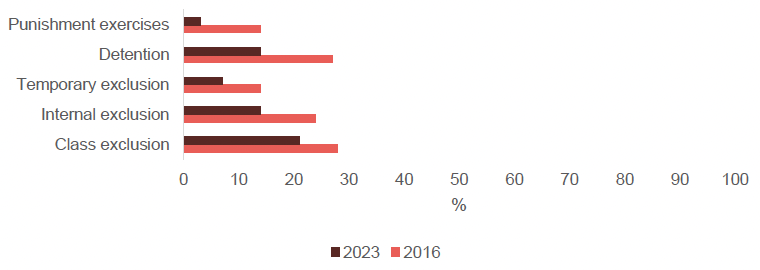
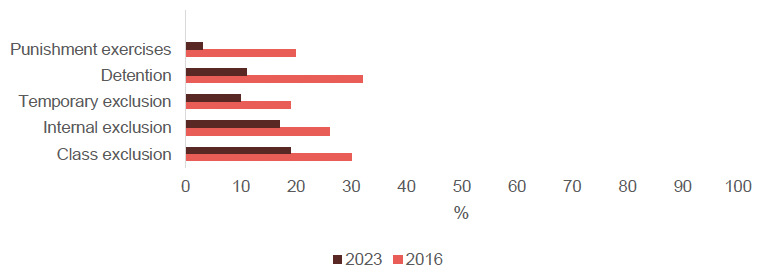
There were no notable increases in the proportion of both primary headteachers and teachers reporting the use of any of the 32 approaches.
Changes over time in approaches used in secondary schools
Between 2016 and 2023, there have been changes in the proportion of secondary staff reporting the use of approaches ‘frequently’ or ‘sometimes’ for around two-thirds of the 32 approaches included in the survey (Figures 9.3 and 9.4).
For around a third of these approaches, there were reductions between 2016 and 2023 in the proportion of both secondary headteachers and secondary teachers reporting their frequent use. The most notable reductions were in the use of punishment exercises, detention, temporary exclusions from school and buddying/peer mentoring. For a further third of the approaches, reductions were only seen among secondary teachers. The most notable reductions in the frequency of use among secondary teachers were recorded in anti-bullying policies and programmes, broad curriculum options (such as vocational opportunities and personal and social development programmes), pupils actively being involved in developing ideas and activities in the school (e.g. pupil council), sharing appropriate strategies and approaches within school/staff and referral to SMT/HT.
In contrast, there was only one approach where reported use had increased. Both headteachers and teachers reported an increase in the use of nurture approaches (85% of secondary headteachers and 69% of secondary teachers 2016, compared with 95% of secondary headteachers and 77% of secondary teachers in 2023.
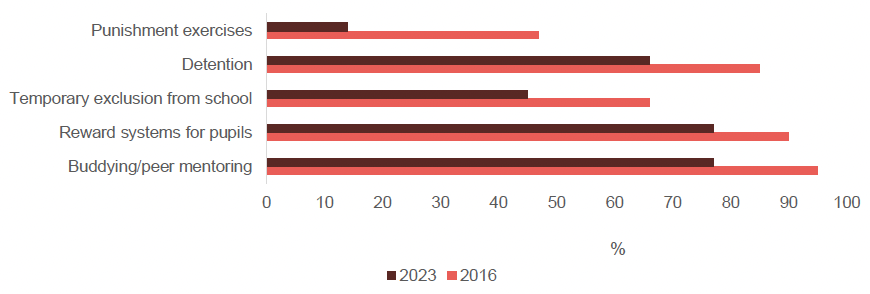
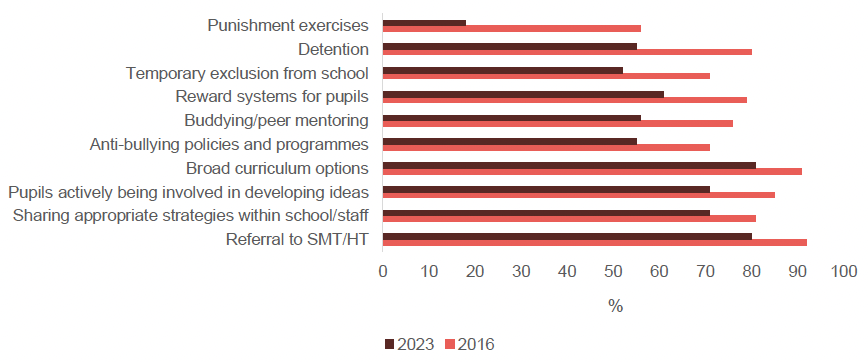
A culture shift in how behaviour is understood and managed
Qualitative participants spoke of a ‘culture shift’ since 2016 in how behaviour is understood, with approaches to behaviour moving away from what they described as ‘discipline’ and ‘punitive measures’ towards increased use of Nurture principles and restorative practice. For example, headteachers spoke of never or rarely excluding pupils; whereas, in the past, rates of exclusion would have been much higher. Instead, relationships were viewed as being central to the way headteachers approached behaviour in their schools.
"I don't want any punitive punishments, we don't have that […] in my old school when I was a PT, if a child had misbehaved, they would be on the seats outside the office sitting in shame. It's not like that anymore so I think that's an improvement. It's about conversations, it's about developing awareness in the children, and I suppose having parents on board. I prefer to do - I don't call it discipline because it's not about discipline - but it's about the relationships. I like to do it in partnership with them so it's probably my own capacity that's improved over the years to be able to do all these things." (Primary headteacher)
School staff expressed the view that gaining respect was a two-way process, with staff earning pupils’ respect through forging strong relationships with them.
"It's very much about gaining respect in different ways, and making sure that that's because you're very respectful in the relationships that you lead with pupils. It's much less punitive, it's much less authoritarian than it was, hugely." (Secondary teacher)
While Chapter 5 demonstrates worsening levels of disruptive behaviour since 2016, LA representatives and headteachers reported improvements in terms of schools understanding the effect of trauma on pupil behaviour and how staff approach relationships. There was also a view that language at LA and headteacher level is now more trauma informed, and displays an increased understanding of neurodiversity and pupils with additional support needs.
Several factors were identified as contributing to this culture shift:
- National policy such as GIRFEC and Scottish Government relationships and behaviour guidelines (Included, Engaged and Involved II) were mentioned by both primary and secondary staff, particularly in terms of the national push to reduce exclusion rates.
- Staff training on Nurture principles, de-escalation and relational practice was reported to have helped to provide staff with an understanding of child brain development, the impact of trauma on pupils and their behaviour.
- Staff noted that concerns for pupils’ wellbeing had increased as a result of COVID-19 and that this had impacted on the approaches taken to behaviour.
- Staff also noted an increasing understanding that punitive measures were not working and that different approaches were needed.
- In some schools, the shift away from punitive behaviour approaches was driven by new headteachers.
- Changes in teacher staffing in some schools were said to have made a difference with new teachers keen to try different approaches.
- Perceived changes to the relationships between teachers and pupils, not just in terms of respect but more widely in terms of a willingness among teachers to build relationships, and an awareness of the importance of this in terms of promoting positive behaviour.
This shift in culture was most evident at LA and headteacher level. LA representatives and, less frequently, headteachers tended to conceptualise approaches to behaviour as focusing on relationships and restorative practice. However, the extent to which these approaches had been embedded across the school varied, with some teachers and support staff remaining sceptical as to the effectiveness of positive approaches. This is further explored later in this chapter.
Managing low level disruptive behaviours
Headteachers and teachers were asked to select up to three of the 32 approaches to behaviour management and relationship building that are frequently used in their school to deal with low level disruptive behaviours.
Approaches frequently used in primary schools to manage low level disruptive behaviour
The three mostly commonly selected approaches among primary headteachers and primary teachers (Figure 9.5) to deal with low level disruptive behaviour in their schools are: Nurture approaches (56% headteachers, 57% teachers); promotion of positive behaviour through whole-school ethos and values (51% headteachers, 42% teachers) and restorative approaches (40% headteachers, 34% teachers). These are the same three approaches that were selected as being frequently used to deal with serious disruptive behaviour. Primary headteachers are less likely than primary teachers to select using break-time supervision (headteachers 14%, teachers 26%) and reward systems for pupils (headteachers 16%, teachers 24%) as one of the three frequently used approaches in their school. In contrast, headteachers are more likely than teachers to select using promotion of positive behaviour through whole-school ethos and values (51% headteachers, 42% teachers) and curriculum programmes in social and emotional skills and wellbeing (headteachers 30%, teachers 15%).
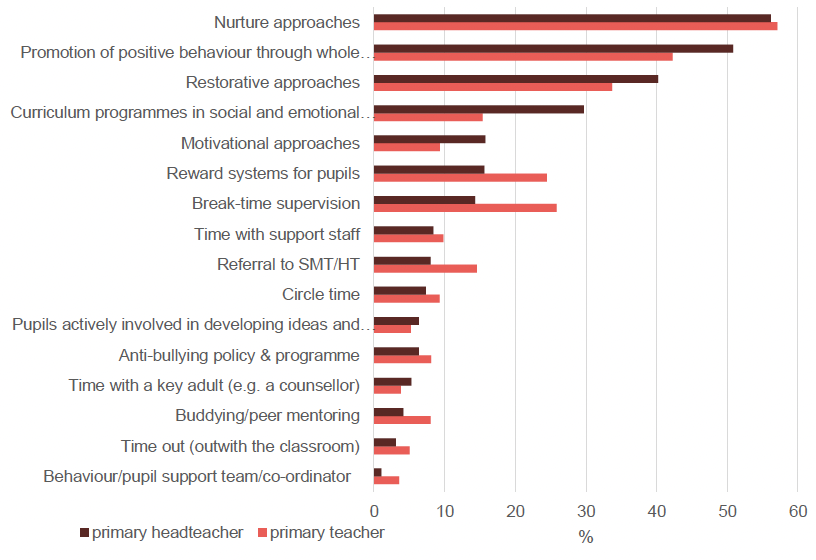
Approaches frequently used in secondary schools to manage low level disruptive behaviour
Secondary headteachers and secondary teachers (Figure 9.6) both selected promotion of positive behaviour through whole-school ethos and values and restorative approaches as one of the three most frequently used approaches in their schools. Headteachers were more likely than teachers to select both the whole-school ethos approach (51% headteachers, 27% teachers) and restorative approaches (45% headteachers, 32% teachers). The third most commonly selected approach by teachers was break-time supervision (26% teachers, 27% headteachers) and for headteachers was Nurture approaches (38% headteachers, 24% teachers).
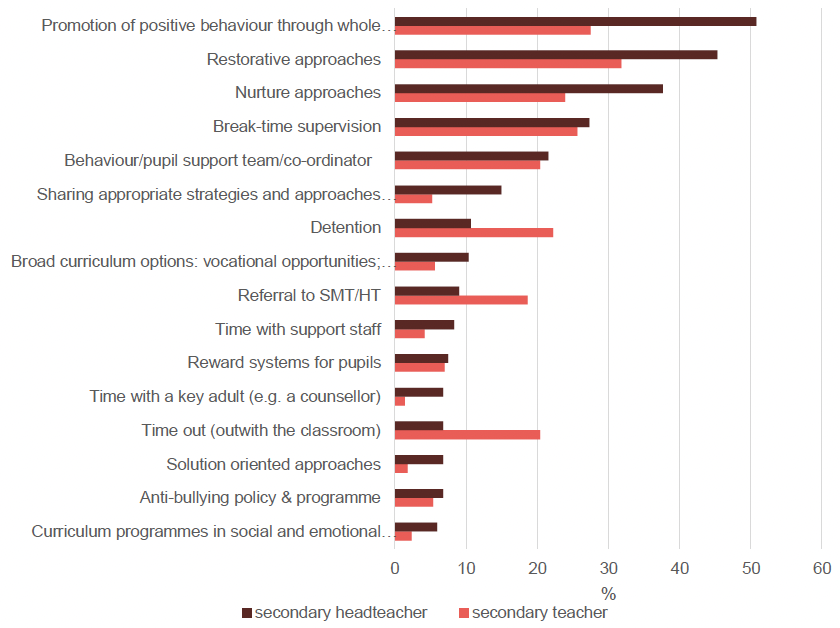
Addressing low level disruptive behaviours in practice
In both primary and secondary schools visited as part of the qualitative research, teachers emphasised the importance of spending time ‘going back to basics’ in promoting behaviour by reinforcing class rules and class charters, introducing rewards systems and focusing on relationships. Teaching and learning techniques were revisited to explore how these could help support relationships and promote positive behaviour. Teachers spoke of using non-verbal cues, having a subtle, quiet word with a pupil rather than calling them out in front of their peers, and reinforcing classroom routines to help reduce disruption, before escalating behaviour to middle managers. Teachers also mentioned using seating plans and adopting ‘three warnings’ systems before considering next steps.
The importance of building strong relationships with pupils was highlighted by school staff irrespective of their role. Knowing pupils and their families, and understanding their backgrounds was seen as critical to being able to manage low level disruption. Headteachers, and their staff, noted the importance of having a ‘visible’ head who is present in school corridors and during breaks/lunchtimes.
“I would say the most visible person in this school is [the headteacher]… Actually, he spends his time getting to know the kids and talking to staff and seeing what's going on, on the ground. I think that's so valuable.” (Secondary teacher)
Curriculum structures were perceived to make it harder to address low level disruption in some cases. Teachers in some smaller secondary schools noted issues around teaching classes with multiple qualification levels (National 3, 4, 5 and Higher) and the ways that this combined approach could make it harder to support all pupils and make disruption more likely.
To a greater degree than among teaching staff, support staff described forging relationships with pupils as being at the heart of their approach to behaviour. Often noting how pupils viewed them as being different to teachers, support staff spoke of how they were able to build upon this difference to build strong relationships based on trust with the pupils they supported. They spent time getting to know them, were aware of what might ‘trigger’ individual pupils and could identify quickly how a pupil was feeling when they arrived at school. Some support staff members spoke of the need to ‘show love’ to pupils, aware that they may have very difficult home lives.
“They just need to hear that [they are loved], a lot of the kids. [The pupils we work with], they’ve not got that family network, not got somebody to come home to at night and the dinner's ready and they can watch a movie or whatever, and someone goes, 'Right, love you, good night'. They then come into school and all those emotions come out in anger and aggression, so they can't get Nurture because they’re too angry and too aggressive.” (Secondary support staff)
However, support staff also discussed some of the challenges they faced in terms of being perceived differently to, and respected less than, teaching staff by pupils who used this as a reason not to listen to them. Other support staff, particularly those in secondary schools, said they were sometimes expected to manage behaviour as a result of teachers being reluctant to step in. This led some support staff to say they felt ‘taken for granted’ by teachers and senior management.
Among headteachers, teachers and support staff, being able to draw upon, model and reinforce school values was seen as particularly helpful due to the consistent message it helped staff to convey. Despite this, the lack of consistency in the strategies used by different teachers across the school was mentioned by headteachers, teachers and support staff. It was felt the inconsistent approaches to managing behaviour experienced by secondary pupils moving between classes could be confusing and impact detrimentally on behaviour. This was particularly noted in relation to teachers’ strategies for dealing with pupils using their phone in class.
Managing serious disruptive behaviours
Headteachers and teachers were asked to select up to three types of approaches that their school frequently uses to deal with serious disruptive behaviour from the 32 approaches already presented to them.
Approaches frequently used in primary schools to manage serious disruptive behaviour
The three most commonly selected approaches among primary headteachers and teachers (see Figure 9.7) are: Nurture approaches (60% headteachers, 52% teachers); promotion of positive behaviour through whole-school ethos and values (50% headteachers, 43% teachers); and restorative approaches (46% headteachers, 28% teachers). Around a quarter of primary teachers also selected referral to SMT/HT (26%) and break-time supervision (25%) as one of the three types of approaches that their school frequently uses.
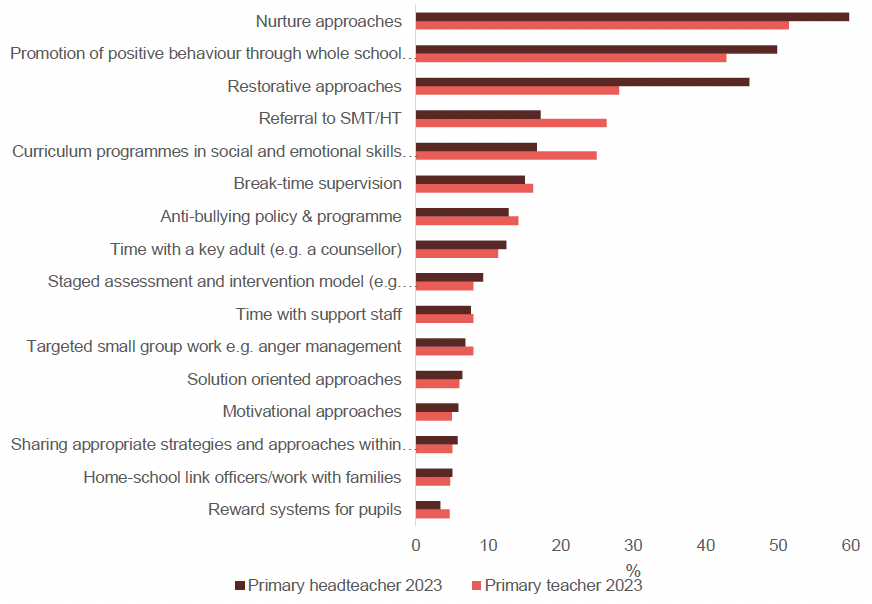
Primary headteachers are more likely than primary teachers to select the use of restorative approaches and time with a key adult (e.g. counsellor) (13% headteachers, 3% teachers). Primary headteachers are less likely than primary teachers to select using referral to SMT/HT (17% headteachers, 26% teachers); break-time supervision (15% headteachers, 25% teachers); and reward systems for pupils (3% headteachers, 16% teachers).
Approaches frequently used in secondary schools to manage serious disruptive behaviour
Secondary headteachers and teachers both select Nurture approaches (34% headteachers, 23% teachers) and restorative approaches (33% headteachers, 29% teachers) as one of the three frequently used approaches to deal with serious disruptive behaviour. In addition, secondary teachers select using referral to the SMT/HT (22% headteachers, 29% teachers) whereas secondary headteachers select promotion of positive behaviour through whole school ethos and values (37%) as one of the three frequently used approaches in their schools.
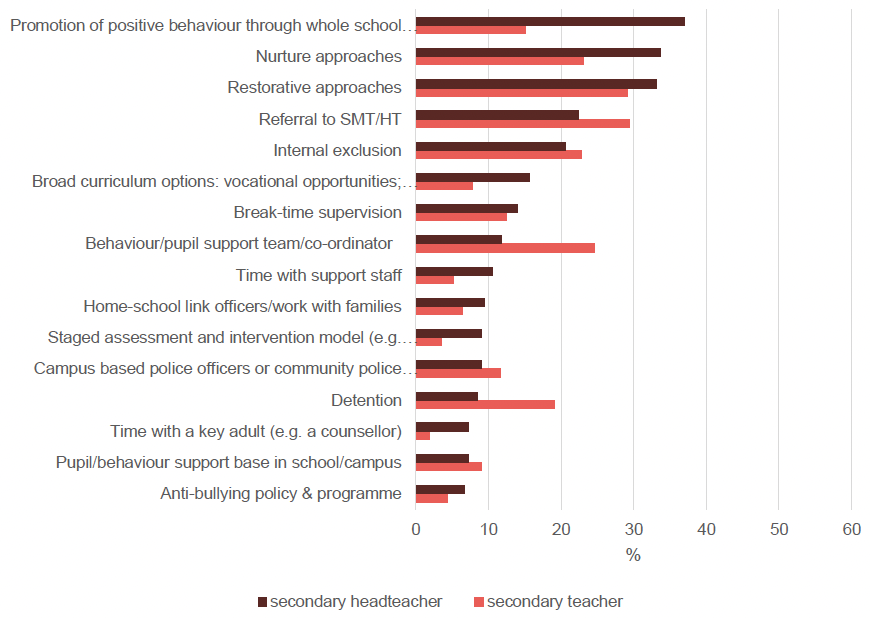
Managing serious disruption in practice
In the primary schools which participated in the qualitative research, there was a focus on Nurture and restorative practice to help manage serious disruption and support those displaying dysregulated behaviour. Some pupils had been offered additional support from members of support staff, but this was not always available due to staffing pressures. Some primary schools had introduced sensory rooms with lights, sounds and soft furnishing designed as spaces for pupils to go to calm down. However, the physical layout of some open plan primary schools meant it was not always easy to provide pupils with a time-out space, or a space they could go to calm down.
"I think schools struggle a wee bit even in terms of space because even if they're doing [whole-school Nurture], one of the challenges is the physical environment sometimes. There's just not space if children are dysregulated for them to get time where they can calm down." (Local authority representative)
In the secondary schools visited, school staff at all levels spoke of Nurture and using restorative approaches in managing serious disruption and supporting those displaying distressed behaviour. However, it was felt that restorative conversations sometimes only had minimal impact on behaviour (see Effectiveness of approaches section below for a detailed discussion of this), and staff instead noted the use of various other strategies.
Both primary and secondary schools mentioned adopting ‘reduced’ timetables for some pupils. This could include different start times for pupils to avoid them coming into contact with other pupils or specific members of staff. Elsewhere, they were adopted as a means of a phased return for pupils who had been excluded or had been anxious about coming to school. The use of ‘bespoke’ or ‘personalised’ timetables was also adopted in both primary and secondary schools to help tailor timetables towards pupils’ interests or abilities as a further means of helping them to remain in school in the face of more serious and disruptive behaviour.
Despite the previously discussed culture change in schools, staff in some schools continued to use what they described as more “punitive” measures to assist with managing more serious incidents of challenging pupil behaviour. Detentions were still in use in both primary and secondary schools, albeit as a time for reflection in some schools, as were phone calls home to parents.
Internal exclusion – being removed from the classroom to study in a different classroom or in a support base – was relatively commonly cited by secondary school staff in particular. This was variously referred to as ‘classroom extraction’, ‘seclusion’ or ‘internal exclusion’. Teachers and support staff had mixed views of this. While some staff appreciated the respite this offered both staff and pupils, others highlighted pupils who were familiar with the ways in which behaviour incidents were escalated and purposefully sought to cause disruption so as to be removed from a lesson they did not wish to attend.
As a last resort, some schools (mainly secondaries, but also some primaries) used exclusion. A secondary headteacher expressed concern at how their school’s exclusion rate might be perceived by the LA, but stressed the importance of balancing the rights of a dysregulated child with the health and safety of other pupils.
“Verbal abuse of staff is usually an exclusion or an alternative to exclusion where they're not excluded but they're not in class for a couple of days, and the restorative conversations with a year head or a teacher or other pupils, things like that. The alternative to exclusion, I would say, a nurturing but educational approach where pupils sign a contract where they reflect on what happened, what will happen next time, who was impacted, that kind of thing.” (Secondary teacher)
School staff also outlined some of the systems schools had introduced to help staff call for additional support in the classroom when needed. These included:
- A ‘red card’ system so that pupils could take a red card to a member of the school leadership team if a class teacher required support.
- Walky-talkies and phones in classrooms to allow teaching and support staff to communicate with one another and the school leadership team, and often used by staff monitoring corridors.
- A “duty head” system with staff allocated to be on call and available if needed.
- A door-fob system for external school doors in primary schools.
Development and promotion of policies and strategies on positive relationships and behaviour
The survey asked primary and secondary headteachers to identify school community members actively involved, over the last 12-months, in discussing and developing strategies for dealing with disruptive behaviour and the promotion of positive behaviour and relationships in their schools.
Primary and secondary headteachers report teachers (96% primary headteachers, 97% secondary headteachers); learning assistants/support staff (88% primary, 74% secondary); pupils (80% primary, 87% secondary); parents (74% primary, 67% secondary); and educational psychologists (71% primary, 69% secondary) as being actively involved in developing disruptive behaviour strategies in their schools.
Around half (56%) of primary headteachers also identify lunchtime/playground assistants as being actively involved in strategy development in their schools. While a similar proportion of secondary headteachers identify campus police or community officers (53%) as being actively involved in strategy development.
Changes in school community members involved in developing strategies on disruptive behaviour over time
The reported level of active involvement in developing primary school strategies fell between 2016 and 2023 among amongst lunchtime/playground assistants (68% of primary headteachers in 2016, compared with 56% in 2023), pupils (89% in 2016, compared with 80% in 2023) and school caretakers/janitors (26% in 2016, compared with 19% 2023).
The reported involvement of social workers in secondary school behaviour and relationship strategy development has also decreased over time. For example, 40% of secondary headteachers reported their active involvement in 2016, compared with 28% in 2023.
How changing approaches to promoting positive behaviour are reflected in school and LA policies
The majority of schools which took part in the qualitative research (primaries and secondaries) had policies in place or were in the process of developing new policies, most of which were framed around positive relationships rather than behaviour management. At the heart of many of the policies was a focus on school values. Several schools mentioned having established Behaviour Groups to revamp school policies. However, in other schools, the nature of relationships and behaviour policy was unclear. Some secondary schools had developed policies specifically around the use of mobile phones in school (for example, pupils handing in their phones to the teacher at the start of the lesson), though it should be noted these were thought to have had varying degrees of success.
Among LA representatives, the shift towards the promotion of positive relationships was frequently raised. As well as the drivers to the updating of behaviour policies mentioned by schools, the influence of the UN Rights of the Child was also highlighted, as was that of pupil voice and children’s rights, Angela Morgan’s review for the Scottish Government of additional support for learning and approaches which recognise the impact of trauma on brain development. Some LA representatives said their authority had updated its guidance around exclusions policy while others said there was no current guidance in place around exclusion. While many LA representatives said their LA had a positive relationships policy in place across the authority, others said they did not have a central policy around relationship-based practice and that it was instead up to schools to develop their own policies on relationships and Rights Respecting Schools.
Promotion of policies on positive relationships and behaviour
In the survey, teachers and support staff were asked on a scale from 1 being ‘poor’ to 5 being ‘very good’ to rate ‘How your school promotes policies on positive relationships and behaviour.’
Among primary school staff, 72% of both teachers and support staff rated their school as either 4 or 5 (Table 9.3). Ratings among both staff types have decreased since 2016 when 81% of teachers and 82% support staff rated their school as 4 or 5. Secondary school staff are less likely to score their school highly with 46% and 51% of support staff and teachers respectively rating either 4 or 5. Among teachers, the proportion giving this rating had decreased from 52% in 2016. Among support staff this has remained similar to 2016.
| Primary (%) | Secondary (%) | |
|---|---|---|
| 1 – Poor | 2 | 7 |
| 2 | 4 | 15 |
| 3 | 21 | 31 |
| 4 | 37 | 29 |
| 5 – Very good | 35 | 18 |
| Unweighted base | 617 | 1536 |
Headteachers were similarly asked on a scale from 1 being ‘poor’ to 5 being ‘very good’ to rate ‘How the education authority works in partnership with your school to promote positive relationships and behaviour.’ Nearly half of primary school headteachers (49%) and 44% of secondary school headteachers rate this as 4 or 5. Around a third (32%) of primary headteachers rated this as a 3, indicating neutral, with a similar proportion (37%) of secondary headteachers giving the same rating. A smaller proportion of primary headteachers (14%) rated gave this a rating of 1 or 2 compared with secondary headteachers (24%).
Perceptions of school ethos
All staff were asked on a scale from 1 being ‘poor’ to 5 being ‘very good’ to rate ‘the overall ethos of your school.’ As in previous years, primary headteachers, teachers and support staff are generally positive about their school ethos: 95% headteachers, 80% of teachers and 76% of support staff gave this a rating of 4 or 5. This has dropped among teachers from 86% in 2016 but remained the majority at 80% (Figure 9.9).
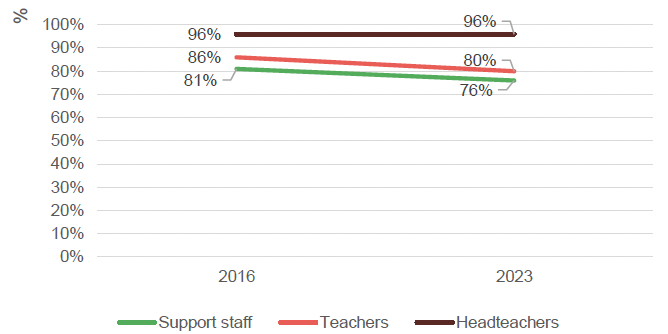
Secondary headteachers are also positive about their school ethos with 86% giving a rating of either 4 or 5, however this has decreased since 2016 (95%). Teachers and support staff are less likely to rate their school ethos highly with 53% of teachers and 51% of support staff giving a rating of 4 or 5. These ratings have also decreased since 2016 (65% teachers, support staff 62%) (Figure 9.10).
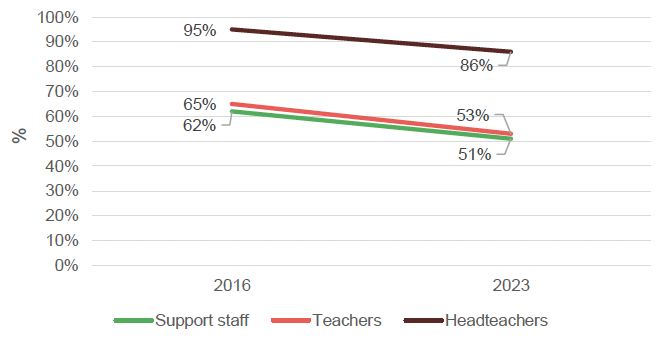
Similar to previous years, primary school staff were more positive than secondary school staff about their school ethos, with 79% giving a rating of 4 or 5, compared with 53%. The most marked between primary and secondary staff was among teachers with 80% of primary school teachers giving a rating of 4 or 5 compared with 53% of secondary school teachers (as shown in Table 9.4 below).
| Primary (%) | Secondary (%) | |
|---|---|---|
| 1 – Poor | 2 | 6 |
| 2 | 2 | 13 |
| 3 | 16 | 28 |
| 4 | 38 | 33 |
| 5 – Very Good | 42 | 20 |
| Unweighted base | 619 | 1536 |
Effectiveness of approaches promoting positive relationships and behaviour
This section explores staff’s views of the effectiveness of approaches used to support positive relationships and manage disruptive behaviour. It includes findings from both the survey and interviews and focus groups with school staff and LA representatives.
School culture regarding developing positive relationships and behaviour
The survey asked all staff about the extent to which they agreed or disagreed that ‘Our school has a culture of developing positive relationships and behaviour for the health and wellbeing of all.’
Most staff agree with this statement though agreement was higher in primary (84%) than secondary (62%) schools. Headteachers were the group most likely to agree (98% in primary and 97% in secondary schools). In primary schools, teachers were more likely to agree (85%) than support staff (79%) whereas in secondary schools, views of teachers and support staff were similar (62% and 63% agreeing, Table 9.5). Primary school teachers of P4-7 were slightly more likely to agree with this statement than were teachers of P1-3 of (86% and 82% respectively).
| Those that agree (either agree strongly or agree) | Headteachers (%) | Teachers (%) | Support staff (%) |
|---|---|---|---|
| Primary | 98 | 85 | 79 |
| Secondary | 97 | 62 | 63 |
| Unweighted base (Primary) | 218 | 641 | 450 |
| Unweighted base (Secondary) | 129 | 1,602 | 577 |
There has been a fall since 2016 in the proportion of teachers and support staff agreeing that their school has a culture of developing positive relationships and behaviour for the health and wellbeing of all. As shown in Figures 9.11 and 9.12, this has decreased among teachers (from 90% to 85% in primaries and 67% to 62% in secondaries) and among support staff (from 89% to 79% in primaries and 74% to 63% in secondaries).
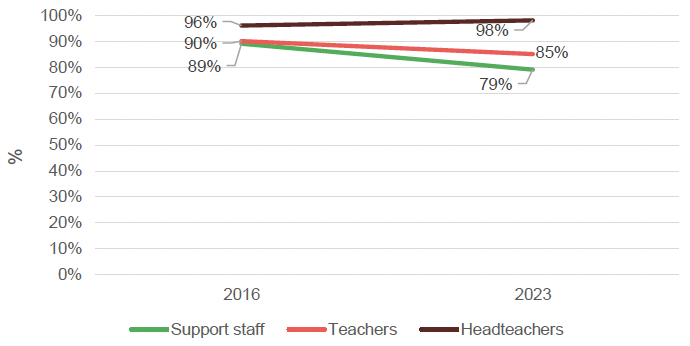
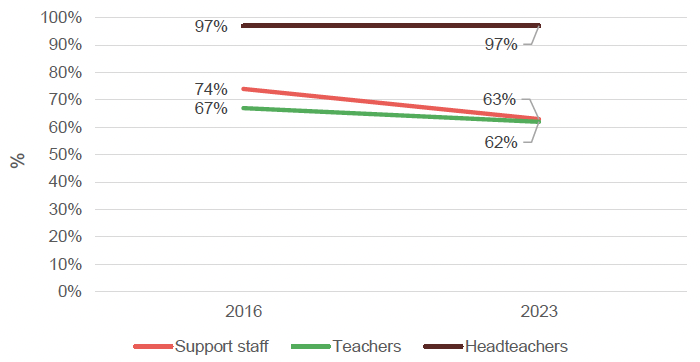
Perceptions of whole school approach to promoting positive relationships and behaviour
Headteachers and teachers responding to the survey were asked the extent to which they agree or disagree that ‘My school has a clear and comprehensive whole school approach to promoting positive relationships and behaviour.’ Primary and secondary headteachers are equally as likely to agree with this statement (92%). However, teachers have a less positive view; 73% percent of primary teachers and 53% of secondary teachers agree on this point. As shown in Table 9.6, there is a particularly large difference in the views of headteachers and teachers in secondary schools (92% compared with 53% agreeing with this).
| Those that agree (either agree strongly or agree) | Headteachers (%) | Teachers (%) |
|---|---|---|
| Primary | 92 | 73 |
| Secondary | 92 | 53 |
| Unweighted base (Primary) | 218 | 636 |
| Unweighted base (Secondary) | 129 | 1,598 |
Teachers’ confidence in promoting positive behaviour in the classroom
Teachers were asked to rate their confidence in their ability to ‘promote positive behaviour in your classroom’ and ‘respond to indiscipline in your classroom’ on a scale of 1 to 5 (1=’not confident at all’ and 5=’very confident’). Confidence levels were high. In relation to promoting positive behaviour, 94% of primary teachers and 91% of secondary teachers gave a rating of 4 or 5. This remains the same as in 2016. In relation to responding to indiscipline, 82% of primary teachers and 81% of secondary teachers gave a rating of either 4 or 5. This has decreased since 2016, from 89% among primary and 86% among secondary teachers.
Time spent on supporting relationships and behaviour
In the survey, headteachers and teachers were asked to estimate the time they spent in the last full teaching week on eight different types of activity related to supporting relationships and behaviour. They could indicate either ‘no time spent’, ‘under one hour’, ‘1-3 hours’ or ‘over 3 hours’). The figures are shown in Supplementary tables 9.39-9.46.
Both primary and secondary headteachers spend more time than primary and secondary teachers on all eight types of activity.
Primary headteachers spend most time each week on activities related to supporting relationships and behaviour on reactive actions: dealing with disruptive behaviour referrals from staff (24% spend ‘over 3 hours’ a week, 38% ‘1-3 hours’); dealing with the same pupils who present challenging behaviour (24%, ‘over 3 hours’, 37% ‘1-3 hours’), and planning or providing behaviour support to individual pupils (22%, ‘over 3 hours’, 44% ‘1-3 hours’).
Primary teachers spend most time each week dealing with the same pupils who present challenging behaviour (12%, ‘over 3 hours’, 38% ‘1-3 hours’).
Secondary headteachers spend most time referring or liaising with other staff about particular pupils (36% spend ‘over 3 hours a week’, 53% spend ‘1-3 hours’); dealing with disruptive behaviour referrals from staff (29% spend ‘over 3 hours’ a week, 39% ‘1-3 hours’); and dealing with the same pupils who present challenging behaviour (22%, ‘over 3 hours’, 59% ‘1-3 hours’).
Secondary teachers spend most time dealing with the same pupils who present challenging behaviour (12%, ‘over 3 hours’, 48% ‘1-3 hours’).
Changes over time in time spent on supporting relationships and behaviour
Between 2016 and 2023 there have been increases in the proportion of both primary and secondary headteachers who report spending 3 or more hours per week dealing with disruptive behaviour referrals from staff (12% of primary and 14% of secondary headteachers in 2016 compared with 24% and 29% respectively in 2023) and dealing with the same pupils who present challenging behaviour (13% of primary and 7% of secondary headteachers in 2016 compared with 24% and 22% respectively in 2023).
There has been an increase in the proportion of primary headteachers spending ‘3 or more hours’ per week planning or providing behaviour support to individual pupils (10% in 2016, 22% in 2023). The proportion of secondary headteachers who reported spending 3 or more hours per week referring or liaising with other staff about particular pupils has also doubled from 17% in 2016 to 36% in 2023.
Views on the effectiveness of approaches
This section outlines school staff and LA representatives’ views of the effectiveness of different approaches used (at national, local authority and school level), outlining their views of what was said to be working well and what was seen as more challenging.
Positive impacts of particular programmes and broader approaches
Qualitative research participants highlighted the impact of positive approaches such as Nurture principles, restorative practice and trauma-informed approaches. In particular, the focus on school values was viewed as a helpful approach at both primary and secondary level, and as contributing towards a positive school ethos. Adopting new, or revising old, school values was said to bring consistency across the school and help staff to set high expectations of behaviour standards, particularly in primary schools.
“We have three [values] in this school, so that's being kind, being safe and being respectful and that language is embedded in everything that we do. That's something that we speak to parents about and try and get that consistency from home to school as well.” (Primary teacher)
Similarly, celebrating the success of pupils – either through positive phone calls home, use of rewards systems or praise postcards – was perceived as helping pupils to feel safe and valued. While school staff noted that schools were focusing more on positive behaviour than they might have in the past, staff in some schools called for more of a focus on this.
Staff in primary schools spoke of the benefits of using curriculum programmes in social and emotional skills and wellbeing, noting that they had helped children to better understand and regulate their emotions and to communicate to staff how they were feeling. It was felt these had enabled schools to develop a consistent approach among staff through the use of shared language. While staff felt these helped the majority of children, it was noted they did not always work for the most dysregulated children.
At secondary level, staff highlighted the considerable impact of training on relational practice on both whole-school and individual teachers’ approaches to relationships and behaviour. Schools which had adopted peer mentoring programmes in addressing gender-based violence also found it helpful. Staff in a secondary school noted how useful this had been in dealing with a rise in misogyny among some pupils they linked to social media influencers. In those secondary schools which had introduced policies on mobile phones, and, importantly, where they had been adopted consistently, these were said to have made a difference in terms of reducing disruption associated with phones.
Nurture approaches in practice
Local authority representatives and school staff, particularly headteachers and those responsible for pastoral support, highlighted the benefits of adopting Nurture and restorative approaches in terms of contributing to improved understandings of trauma and its impact on pupil behaviour. In those schools which had allocated physical spaces and, in some cases, dedicated staff, for Nurture, this was seen to have been particularly helpful, particularly in secondary schools where this had been developed alongside alternative learning provision and new approaches to the curriculum.
Whilst many school staff members reported receiving training in Nurture principles or that their school had implemented these principles, understanding of what it meant to be nurturing varied somewhat. In some schools which had adopted nurturing approaches, these existed alongside more punitive measures. A minority of teachers stated that sometimes direct consequences or punitive measures were appropriate. This conflict in approach was highlighted by an LA representative.
"I think that's a huge learning curve, because some people are going to schools and they go, 'Yes, we're a nurturing school' and then next minute I hear a child being absolutely bawled at by a member of staff and I'm like, ‘that's not very nurturing’." (Local authority representative)
There also appeared to be some confusion as a result of the duality of Nurture – in that in some schools it could be both a physical space (‘the Nurture base’) and an overarching approach. In schools which had a space for Nurture, this was targeted at specific pupils identified by the school. Some teachers said they did not always understand the criteria for selecting pupils for Nurture support, and in some schools there was a lack of communication around the aims of the Nurture bases and which pupils they were aimed at. One critique of Nurture was that staff perceived that some pupils who would benefit most from Nurture were said by the school to be ‘ineligible’ for support through this route. This tended to be some of the most challenging and dysregulated pupils whose behaviour was considered too aggressive for Nurture groups.
Challenges associated with restorative approaches
While LA representatives and school headteachers interviewed as part of the qualitative research were generally positive about the use of restorative approaches, teachers and support staff expressed more mixed views. Some staff found restorative approaches to have little impact, particularly among those pupils whose behaviour was the most dysregulated. Teaching staff reported that the use of restorative conversations after a disruptive incident which led to a pupil being removed from the classroom could feel ‘tokenistic’. Teachers and support staff also questioned the sincerity of pupils ‘who know what to say’ during these conversations. School staff from all levels pointed to the difficulty of managing disruption caused by pupils who appeared not to care about the impact of their behaviour or about any sanctions they were handed as a result.
"I don't think it's a good thing in the long term. I think it will keep getting worse behaviour – Nurture, if properly implemented could work, but just now I feel it's a bit like you just get away with what you're doing. If you then go and have a chat, then they say they're sorry, and then they're back in, but they know what to say." (Secondary teacher)
The time needed from both staff and pupils to be able to implement restorative practice properly and to allow time for people to fully reflect on their actions was cited as a factor which may limit the effectiveness of restorative approaches.
Perceived lack of consequences associated with current approaches to behaviour
Both primary and secondary staff frequently expressed the view that the current focus on positive relationships and behaviour means that pupils have little understanding of the consequences of their actions. This was more strongly seen among teachers (including experienced teachers and those who were newer to the profession) and support staff than among headteachers. In some schools visited as part of the qualitative research, conflicting views were expressed between headteachers and senior leaders and those of class teachers and support staff. For example, support staff in a school which the head said was centred around nurturing and restorative approaches questioned the lack of perceived consequences of disruptive behaviour for pupils.
“Quite often they're taken out of the classroom, spoken to and then put right back and it seems to have little effect. You were talking about this particular child on the bus that was squirting juice and being disrespectful and goading another pupil. Yes, they get a talking to, but it doesn't have any effect on these particular pupils. It's like water off a duck's back. You could stand that child in the corner and tell him how disrespectful that is. ‘What do you think you're doing? How do you think that makes other people feel?’ They're like, 'I don't know’.” (Secondary support staff)
There was a view among some school staff (mainly teachers and support staff) that current approaches do not adequately prepare young people for the realities of the workplace or for their place in society more widely.
"I think it's added to the increase in the low level disruptions, etc. There's no clear rules, sanctions, consequences, boundaries. Everything's become very muddied. Like I say, that's how society works. We have rules that we all agree on in the best interests of everybody, and there are consequences if you break those rules, whereas we seem to have become - with children in Scotland – no, there are no rules, there are no consequences." (Secondary teacher)
“I got no apology from the student in question and that's hard. That is hard, because I firmly believe if this child acted like this in a workplace they wouldn't have a job now. So we are actually in a way – when I say 'we', the school – are failing these kids in the respect that if they go into a workplace which we're trying to set them up for, no workplace, no employer is going to take what I took.” (Secondary support staff)
Part of the reason that some staff gave for their resistance to these approaches related to their views on equity, and how other pupils might perceive it to be ‘unfair’ that a child who misbehaved might then have time out with staff or be allocated Nurture time. This view was present among both primary and secondary class teachers and support staff. While most were sympathetic to the challenges some pupils faced in their home lives and the ways in which this might be reflected in their school behaviour, it was felt that it could foster resentment among pupils.
"Sometimes as I've said I've seen instances with children being offered tea and biscuits to talk about their behaviour. Now you've got students who are behaving really well in the class. They do not get that. They don't get that chance to sit outside the class and talk about their expectations. They don't get free food offerings or drink offerings. So it's started to cause resentment amongst general students and of course other students are getting away with quite poor behaviour. They're seeing how their behaviour is also being allowed." (Secondary teacher)
This view was also shared by some LA representatives. Other LA representatives interviewed acknowledged the desire among teachers for the return to more punitive approaches. Teachers also highlighted the difficulty of knowing what to do with pupils where all other approaches or strategies had been exhausted and their disruptive behaviours continued.
Mismatch between national/LA policy and individual school’s approaches
School staff highlighted a perceived mismatch between the positive approaches espoused at both a national and LA level and the realities of dealing with violent and aggressive incidents in schools.
While noting the need for a trauma-informed approach to dysregulated pupils, school staff at all levels expressed concern that the health and safety of other pupils was in danger of being neglected. In particular, staff in secondary schools which had high levels of serious disruption highlighted the pressure they were under from the LA and national guidance to reduce pupil exclusions.
"The first principle of Nurture is that school is a safe space. As soon as school is not a safe space, we have a big problem, but to make school a safe space, we have to use some of those harder-edged tools that are at our disposal, including exclusion, to ensure that safety is maintained for all. That is not politically palatable, and it is not accepted within the current policy narrative." (Secondary headteacher)
Both teachers and support staff noted how current school policies discourage, and in some cases, forbid staff from physically intervening in the event of a serious behaviour incident. Staff spoke of the difficulty of having to ‘stand by’ while pupils, for example, ‘destroyed’ a classroom. Some staff interviewed said these more violent situations were the most difficult to manage, given the levels of threat and intimidation experienced during these incidents and their desire to keep other pupils in the vicinity safe. As some support staff noted, it was not always considered practical or safe to avoid intervention when considering the potential impact on other pupils. In such situations, staff spoke of their ‘instincts’ kicking in to help manage challenging situations. This led some support staff to contravene school policies to ensure the safety of pupils.
“I know we have a hands-off policy, but in that situation it's not really a choice thing. I'm a parent and I would hate to hear that an adult presence was there while somebody punched seven shades out of my son.” (Secondary support staff)
Changes staff would like to see in relation to approaches
The qualitative interviews asked school staff and local authority representatives what future changes they would like to see introduced at a local and national level which could help them promote relationships and manage serious disruption in schools.
Need for consistency in approaches to behaviour
School staff identified a need for greater consistency in relation to approaches to behaviour. They spoke of how these vary among teachers, and between schools. Staff called for greater clarity at a national level, perhaps in the form of national guidance or policy, as to which behaviours are and are not acceptable and how they might be managed consistently across schools in different areas.
“I think a very sensible thing would be an agreed-upon classroom management approach, and if you had that in every classroom, in every secondary school in a local authority, and it was like, ‘this is [name of] Council's classroom behaviour policy. This is what the teacher will do, and this is what you have to do or this will happen’, and it just makes it simple for everybody.” (Secondary teacher)
Desire for greater consequences in how behaviour is managed
Headteachers, teachers and support staff called for greater consequences to be added to the suite of approaches available. Headteachers and teachers spoke of the need for ‘empowerment’ and ‘the authority’ for teaching staff to have rules and consequences in place. The perceived lack of consequences was said to make it difficult for school staff to implement positive approaches.
“I would say a more firm approach to behaviour management. I don't know exactly what that would look like, but I think we need maybe a wider script to follow with understanding of these children. The approaches we have work for the majority of the children, but children with really challenging backgrounds or additional needs, we need obviously different approaches for them. I think that sometimes we're trying to (have) just one approach for all of the children in the class and that doesn't work.” (Primary teacher)
In particular, there was a view that school staff were running out of options as to how to manage the behaviour of a small core group of young people with whom all other approaches and strategies had been exhausted. Without the option of exclusion and with few options for alternative provision, staff questioned what other options were available to them.
“I talked about the professional impotency. I think that is a little bit of an issue. You sometimes get to the point where you think well, we've tried all the strategies that are open to us and nothing has changed.” (Secondary teacher)
Need for additional resources around inclusion
Headteachers, teachers and local authority representatives related concerns about funding Nurture and the presumption of mainstream policy. Within the context of increasing levels of need, school staff emphasised the importance of providing adequately resourced support. There was a perception that rising proportions of children with ASN (e.g., ADHD, ASD) and young people without formal diagnoses needed higher levels of support to remain in mainstream schools. As a member of support staff noted:
“We don’t have enough staff to be able to deal with the number of children that need constant support.” (Primary support staff)
While the inclusive aims of the presumption of mainstream policy were welcomed, some school staff interviewees expressed concern that to implement these approaches properly required higher levels of resource. This view was also shared by some local authority representatives.
“The presumption of inclusion - which I completely agree with if it's resourced appropriately - has the detrimental impact on some of the learners, if not all learners. Yes, inclusion works if it's sourced and resourced. Inclusion is negative to everybody including the child, who's meant to be being included, if it's not resourced effectively.” (Primary headteacher)
“I think Scottish Government need to think carefully about their policies, like presumption of mainstream. I am absolutely in agreement with children being in mainstream, but you absolutely need the resource to back that up. If mainstream have to support children who, due to current economic, financial, social climate, are expected to manage schools the way schools are set up at this point, we need an awful lot more flexibility in our system to be able to do that.” (Local authority representative)
Desire for alternatives to mainstream for pupils with high levels of need
In some schools, staff interviewed as part of the qualitative research reported trying to support highly distressed and dysregulated young people for whom it was felt mainstream education may not be appropriate. However, staff said the lack of enhanced support provision left schools with little alternative. Across the local authority representatives and school interviews, a lack of provision for enhanced support provision was reported, with the majority of social, emotional and behaviour needs support provided by schools themselves. This was particularly evident in staff in primary schools, among whom there was a clear demand for additional LA support to help support highly dysregulated pupils. Suggestions included more places in enhanced support provision, more opportunities for support through third sector organisations and alternative curriculum options.
“Probably more things like behaviour units and things like that, because people get to the stage where there's nothing more we can do with this pupil, but we've still got to keep them, and then they continue to still disrupt everyone else. I just feel like there needs to be somewhere. You're letting that pupil down because you're not helping them, so it has to move on to somebody else after that. There's only so much a teacher can do.” (Secondary teacher)
“I felt sorry for [the young person] as well, because I'll be honest, this isn't the right environment for that young person to that extent. [The young person is] not coping in here. If you can manage mainstream, great, but there's not enough facilities for young people who really do need the right support and the right environment for them to be able to reach their potential. The council has shut down so many of these establishments. (Secondary support staff)
More widely, some interviewees (both school staff and LA representatives) expressed the view that current traditional teaching structures do not work for some pupils, and called for greater provision of alternative learning options for these pupils.
“This idea that all pupils of age 14 should be at this stage and all pupils by the time they're 16 should be able to do this, I think over time we're waking up to the fact that that's not realistic. So, actually if someone in S3 isn't engaging and isn't buying in to school, why would we continue to try and ask them to attend 32 periods of classes a week? To me it doesn't make any sense. If they had six months out or even a whole session out just doing other stuff to get themselves in a better place where they might then be open to learning, then that's what we should be looking at and then they re-join the system as appropriate.” (Secondary teacher)
Contact
There is a problem
Thanks for your feedback